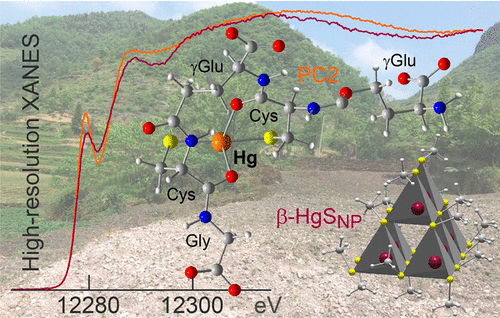当前位置:
X-MOL 学术
›
Environ. Sci. Technol.
›
论文详情
Our official English website, www.x-mol.net, welcomes your
feedback! (Note: you will need to create a separate account there.)
Biogenesis of Mercury–Sulfur Nanoparticles in Plant Leaves from Atmospheric Gaseous Mercury
Environmental Science & Technology ( IF 10.8 ) Pub Date : 2018-03-14 00:00:00 , DOI: 10.1021/acs.est.7b05452 Alain Manceau 1 , Jianxu Wang 2 , Mauro Rovezzi 3 , Pieter Glatzel 3 , Xinbin Feng 2
Environmental Science & Technology ( IF 10.8 ) Pub Date : 2018-03-14 00:00:00 , DOI: 10.1021/acs.est.7b05452 Alain Manceau 1 , Jianxu Wang 2 , Mauro Rovezzi 3 , Pieter Glatzel 3 , Xinbin Feng 2
Affiliation

|
Plant leaves serve both as a sink for gaseous elemental mercury (Hg) from the atmosphere and a source of toxic mercury to terrestrial ecosystems. Litterfall is the primary deposition pathway of atmospheric Hg to vegetated soils, yet the chemical form of this major Hg input remains elusive. We report the first observation of in vivo formation of mercury sulfur nanoparticles in intact leaves of 22 native plants from six different species across two sampling areas from China. The plants grew naturally in soils from a mercury sulfide mining and retorting region at ambient-air gaseous-Hg concentrations ranging from 131 ± 19 to 636 ± 186 ng m–3 and had foliar Hg concentration between 1.9 and 31.1 ng Hg mg–1 dry weight (ppm). High energy resolution X-ray absorption near-edge structure (HR-XANES) spectroscopy shows that up to 57% of the acquired Hg is nanoparticulate, and the remainder speciated as a bis-thiolate complex (Hg(SR)2). The fractional amount of nanoparticulate Hg is not correlated with Hg concentration. Variation likely depends on leaf age, plant physiology, and natural variability. Nanoparticulate Hg atoms are bonded to four sulfide or thiolate sulfur atoms arranged in a metacinnabar-type (β-HgS) coordination environment. The nanometer dimension of the mercury–sulfur clusters outmatches the known binding capacity of plant metalloproteins. These findings give rise to challenging questions on their exact nature, how they form, and their biogeochemical reactivity and fate in litterfall, whether this mercury pool is recycled or stored in soils. This study provides new evidence that metacinnabar-type nanoparticles are widespread in oxygenated environments.
更新日期:2018-03-14











































 京公网安备 11010802027423号
京公网安备 11010802027423号